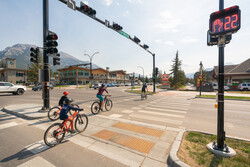
Our Integrated Transportation Plan
The Integrated Transportation Plan is a big-picture strategy that guides how we make transportation choices based on our community’s values. It is a forward-looking plan focused on moving people safely and efficiently, no matter how they choose to travel.
In Canmore, our roads can get busy, especially in the summer. There’s only so much space for cars, and the demand on our roads will only keep growing. Since cars can only carry a limited number of people at a time, we need to encourage more people to use other ways to get around.
Over the past decade, we’ve been transforming our transportation network to make it safer, easier, and more convenient to walk, bike, and bus around town.
Our goals by 2030 include reducing collisions by 10% annually and increasing transit ridership by 20% each year. To maintain our road capacity and community character, we are striving for a target of 40% trips taken by foot, bicycle, or bus on a typical summer day.
Here is how we are doing it:
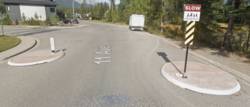
Safety is a key part of our Integrated Transportation Plan to create a transportation network that works for everyone.
Safe, liveable streets that allow people to walk, bike, and drive align with Canmore’s community values and goals. We believe streets should be safe for everyone—people of all ages and abilities using a variety of transportation methods.
Roads can be hazardous, especially when drivers speed or don’t pay attention. Safe street designs help prevent accidents by slowing down traffic, making drivers more aware, shortening crossing distances, and encouraging people to choose safer ways to travel instead of driving.
Here’s what we’re doing:.
- Designing "complete streets" that accommodate all types of travel while making our streets vibrant and welcoming. The goal is to create places where people want to be spend time and are comfortable walking and cycling. This approach to street design supports all modes of transportation, including walking, cycling, transit, and driving. Complete streets also feature attractive streetscapes and public spaces.
-
Reducing speed limits on local and collector roads to 30 km/h to make our streets safer and more livable. Slower speeds encourage people to bike or walk because they feel safer while limiting the likelihood and severity of collisions.
-
Using physical measures like the raised concrete medians and curb extensions you’ve probably seen in your neighborhood. These features slow down traffic and physically separate vulnerable road users. We’ve added traffic calming measures in about 30 locations, which have slowed speeds, shortened crossing distances, and improved visibility for people walking or biking.
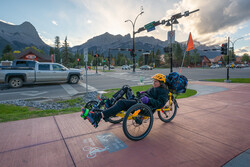
Our trails are open to everyone, no matter their ability or how they choose to get around. We want people to use active transportation by providing a safe, well-connected network that makes it easy and quick to get where they need to go.
We aim to create a trail network that invites both residents and visitors to leave their cars at home or the hotel and enjoy over 80 km of local trails and pathways. These paths allow for all kinds of human-powered travel, including walking, cycling, roller skiing, skateboarding, rollerblading, push scooters, families with strollers, people with mobility aids, and even cross-country skiing in the winter.
Here’s what we’re doing:
- Creating seperated pathways that offer a safe, inviting, and comfortable experience. We’re currently upgrading Bow Valley Trail and have plans for upcoming work on Railway Avenue.
- Developing pathways for different skill levels, from wide, accessible paths to more challenging bike skills terrain.
- Maintaining key routes year-round by clearing snow from priority paths so people can travel safely in all seasons.
- Investing in bicycle infrastructure like bike parking, service stations, and bike lanes to make cycling in town easy and convenient.
- Improving accessibility by adjusting signal timing at intersections to protect people when crossing and by paving and regrading certain pathways. This helps seniors, people with mobility devices, and families with strollers navigate our trail network. For example, the the West Bow River Pathway is now accessible from Three Sisters to downtown. We reduced the slope, widened the path, and paved the surface so everyone can enjoy it, no matter how they travel.
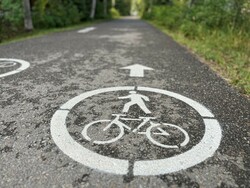
We educate the public and promote safety messages to encourage safe behavior on Canmore’s trails and pathways, making sure they are safe for everyone.
Here’s what we’re doing:
- Painting pathway markings on multi-use paths around town to remind people to keep to the right.
- Installing pathway etiquette signs that remind trail users to be safe and respectful. These signs include messages like “stay to the right except to pass,” “use lights at night,” “please share the trail,” “be aware of your surroundings,” and “let others know when passing.”
- Promoting walking, cycling, and transit travel through educational campaigns and social media to support a shift away from car use. For example, “Moving People” is a major communications focus for 2024/5 as a Big Story.
- Positive ticketing by our Municipal Enforcement team, which rewards respectful trail behavior to reinforce safe actions.
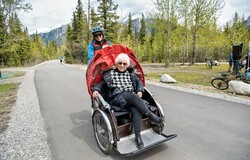
We offer incentive programs and other initiatives that reduce financial or mobility barriers to adopting more sustainable transportation options and enjoying our trails.
Here’s what we’re doing:
- Partnering with the Canmore Community Cruisers on the Bike All Winter Program that provides residents free or subsidized winter bicycle tires, lights and fenders in exchange for a commitment to ride their bike in winter.
- Providing a one-time incentive to Affordable Services Program participants to reduce barriers to e-bike ownership for Canmore residents with the highest financial need.
- Offering FREE local transit for everyone.
- Providing up to a 50% discount on regional Roam Transit passes (Route 3 between Banff and Canmore) for Affordable Services Program participants.
- Pairing local seniors with trained volunteers in our Cycling Without Age Program that takes seniors with limited mobility out for tri-shaw rides to enjoy our trail network and feel the wind in their hair.
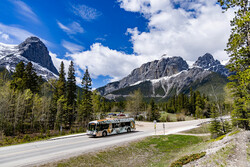
Local transit service provides an alternative mode of transportation and provides mobility for seniors to access community services, and also provides safe transportation for youth. Transit is also one of the most efficient ways to move people in our community.
Here’s what we’re doing:
- Providing free local transit. Through our partners at Roam Transit, your local transit service features three free-fare routes, including Route 12 with service to Quarry Lake, the Nordic Centre, and Grassi Lakes. The growth of the Roam Transit service is nothing short of remarkable, with over 300,000 rides on local Route 5 in 2023 - a 73% increase from 2022!
- Using a paid parking program to support sustainable transportation. The fees, mostly paid by visitors, help fund initiatives like free local transit, making affordable and convenient transportation available to everyone.
- Installing new bus stops and increasing service to make taking the bus more convenient.
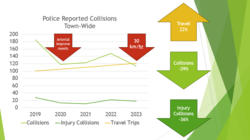
Our Progress So Far
We’ve made big strides in making our transportation network safer and more diverse—and we’ve got the proof.
- Recent actions like lowering speed limits, adding traffic calming measures, offering free public transit, and building new separated pathways have helped reduce the share of summertime personal vehicle travel in our downtown area from 94% in 2013 to 68% in 2023.
- We are currently on-track to meet outr 2030 mode share target of 40% trips taken by foot, bicycle or bus on a typical summer day.
- Our network is also safer and more varied. For example, at the Bow Valley Trail/Railway intersection, the number of trips by foot, bike, and transit has doubled in less than three years and now makes up about 20% of all trips during peak times. This area has also become safer, with a 37% reduction in collisions, a 65% decrease in injury-related collisions, and a 100% reduction in collisions involving vulnerable road users.
- Town-wide, we are also seeing the impacts of these actions with collisions down 39% from 2019, according to RCMP data.
With funding from Infrastructure Canada, we’re conducting a safety study to get more insights into the impact of our work. We’ll share the results with Council and the community in late 2024.
